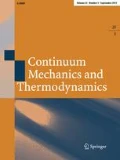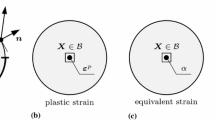Abstract
This paper presents a finite strain constitutive model to predict a complex elastoplastic deformation behaviour that involves very high pressures and shockwaves in orthotropic materials using an anisotropic Hill’s yield criterion by means of the evolving structural tensors. The yield surface of this hyperelastic–plastic constitutive model is aligned uniquely within the principal stress space due to the combination of Mandel stress tensor and a new generalised orthotropic pressure. The formulation is developed in the isoclinic configuration and allows for a unique treatment for elastic and plastic orthotropy. An isotropic hardening is adopted to define the evolution of plastic orthotropy. The important feature of the proposed hyperelastic–plastic constitutive model is the introduction of anisotropic effect in the Mie–Gruneisen equation of state (EOS). The formulation is further combined with Grady spall failure model to predict spall failure in the materials. The proposed constitutive model is implemented as a new material model in the Lawrence Livermore National Laboratory (LLNL)-DYNA3D code of UTHM’s version, named Material Type 92 (Mat92). The combination of the proposed stress tensor decomposition and the Mie–Gruneisen EOS requires some modifications in the code to reflect the formulation of the generalised orthotropic pressure. The validation approach is also presented in this paper for guidance purpose. The \({\varvec{\psi }}\) tensor used to define the alignment of the adopted yield surface is first validated. This is continued with an internal validation related to elastic isotropic, elastic orthotropic and elastic–plastic orthotropic of the proposed formulation before a comparison against range of plate impact test data at 234, 450 and \({\mathrm {895\,ms}}^{\mathrm {-1}}\) impact velocities is performed. A good agreement is obtained in each test.
Similar content being viewed by others
References
Ahmadi, S.F., Eskandari, M.: Vibration analysis of a rigid circular disk embedded in a transversely isotropic solid. J. Eng. Mech. 140(7), 04014048 (2013)
Ahmadi, S.F., Eskandari, M.: Rocking rotation of a rigid disk embedded in a transversely isotropic half-space. Civil Eng. Infrastruct. J. 47(1), 125–128 (2014)
Anderson, C.E., Cox, P.A., Johnson, G.R., Maudlin, P.J.: A constitutive model for anisotropic materials suitable for wave propagation computer program-II. Comput. Mech. 15, 201–223 (1994)
Aravas, N.: Finite-strain anisotropic plasticity and the plastic spin. Model. Simul. Mater. Sci. 2, 483–504 (1994)
Asay, J.R., Shahinpoor, M.: High-Pressure shock compression of solids. Springer, New York (1993)
Banabic, D.: Sheet Metal Forming Processes. Springer, Heidelberg (2010)
Barlat, F.: Crystallographic texture, anisotropic yield surface and forming limits of sheet metals. Mater. Sci. Eng. 91, 55 (1987)
Barlat, F., Lian, J.: Plastic behaviour and stretchability of sheet metals. Part I: a yield function for orthotropic sheets under plane stress conditions. Int. J. Plast. 5, 51–66 (1989)
Belytschko, T., Liu, W.K., Moran, B.: Nonlinear Finite Elements for Continua and Structures. Wiley, Chichester (2000)
Boehler, J.P.: On irreducible representations for isotropic scalar functions. ZAMM 57, 323–327 (1977)
Butcher, B.M.: Behaviour of Dense Media Under High Dynamic Pressure, p. 245. Gordon and Breach, New York (1968)
Campbell, J.: Lagrangian hydrocode modeling of hypervelocity impact on spacecraft. Ph.D. thesis, Cranfield University, Cranfield, UK (1998)
Davison, L., Graham, R.A.: Shock compression of solids. Phys. Rep. 55, 255–379 (1979)
De Vuyst, T.A.: Hydrocode Modelling of Water Impact. Ph.D. thesis, Cranfield University, Cranfield, UK (2003)
Drumheller, D.S.: Introduction to wave propagation in nonlinear fluids and solids. Cambridge University Press, Cambridge, UK (1998)
Eidel, B., Gruttmann, F.: Elastoplastic orthotropy at finite strains: multiplicative formulation and numerical implementation. Comput. Mater. Sci. 28, 732–742 (2003)
Eliezer, S., Ghatak, A., Hora, H., Teller, E.: An introduction to equations of state, theory and applications. Cambridge University Press, Cambridge (1986)
Eskandari, M., Shodja, H.M., Ahmadi, S.F.: Lateral translation of an inextensible circular membrane embedded in a transversely isotropic half-space. Eur. J. Mech. A Solids 39, 134–143 (2013)
Fountzoulas, C.G., Gazonas, G.A., Cheeseman, B.A.: Computational modeling of tungsten carbide sphere impact and penetration into high-strength-low-alloy (HSLA)-100 steel targets. J. Mech. Mater. Struct. 2(10), 1965 (2007)
Grady, D.E.: The spall strength of condensed matter. J. Mech. Phys. Solid 36, 353–384 (1988)
Grady, D.E., Kipp, M.E.: Fragmentation properties of metals. Int. J. Impact Eng. 20(1–5), 293–308 (1997)
Gray, G.T., Bourne, N.K., Millett, J.C.F.: Shock response of tantalum: lateral stress and shear strength through the front. J. Appl. Phys. 94(10), 6430–6436 (2003)
Gruneisen, E.: The State of Solid Body, NASA R19542 (1959)
Hill, R.: A theory of the yielding and plastic flow of anisotropic metals. Proc. R. Soc. Ser. A 193, 281–297 (1948)
Hallquist, J.: Theoretical manual for DYNA3D. Technical report, Lawrence Livermore National Laboratory (1983)
Holzapfel, G.A.: Nonlinear Solid Mechanics, A Continuum Approach for Engineering. Wiley, Chichester (2007)
Itskov, M.: On the application of the additive decomposition of generalized strain measures in large strain plasticity. Mech. Res. Commun. 31, 507–517 (2004)
Itskov, M., Aksel, N.: A constitutive model for orthotropic elasto-plasticity at large strains. Arch. Appl. Mech. 74, 75–91 (2004)
Khan, A.S., Kazmi, R., Farrokh, B.: Multiaxial and non-proportional loading responses, anisotropy and modeling of Ti–6Al–4V titanium alloy over wide ranges of strain rates and temperatures. Int. J. Plast. 23(6), 931–950 (2007a)
Khan, A.S., Kazmi, R., Farrokh, B., Zupan, M.: Effect of oxygen content and microstructure on the thermo-mechanical response of three Ti–6Al–4V alloys: experiments and modeling over a wide range of strain-rates and temperatures. Int. J. Plast. 23(7), 1105–1125 (2007b)
Khan, A.S., Kazmi, R., Pandey, A., Stoughton, T.: Evolution of subsequent yield surfaces and elastic constants with finite plastic deformation. Part-I: a very low work hardening aluminum alloy (Al6061-T6511). Int. J. Plast. 25(9), 1611–1625 (2009)
Lin, J.I.: DYNA3D: A Nonlinear, Explicit, Three-Dimensional Finite Element Code for Solid and Structural Mechanics User Manual. Lawrence Livermore National Laboratory, Livermore (2004)
Lubarda, V.A., Krajcinovic, D.: Some fundamental issues in the rate theory of damage-elastoplasticity. Int. J. Plast. 11, 763–797 (1995)
Man, C.: On the correlation of elastic and plastic anisotropy in sheet metals. J Elast 39(2), 165–173 (1995)
Mandel, J.: Plasticité Classiqueet Viscoplastié, CISM Lecture Notes. Springer, Wien (1972)
Meyers, M.A.: Dynamic Behaviour of Materials. Wiley, Inc., New York (1994)
Mohd Nor M.K.: Modelling Rate Dependent Behaviour of Orthotropic Metals. Ph.D. thesis, Cranfield University, Cranfield, UK (2012)
Mohd Nor, M.K., Vignjevic, R., Campbell, J.: Modelling of shockwave propagation in orthotropic materials. Appl. Mech. Mater. 315, 557–561 (2013a)
Mohd Nor, M.K., Vignjevic, R., Campbell, J.: Plane-stress analysis of the new stress tensor decomposition. Appl. Mech. Mater. 315, 635–639 (2013b)
Mohd Nor, M.K., Mohamad Suhaimi, I.: Effects of temperature and strain rate on commercial aluminum alloy AA5083. Appl. Mech. Mater. 660, 332–336 (2014)
Mont’ans, F.J., Bathe, K.J.: Towards a model for large strain anisotropic elasto-plasticity. In: Onate, E., Owen, R. (eds.) Computational Plasticity, pp. 13–36. Springer, Berlin (2007)
Nakamachi, E., Tam, N.N., Morimoto, H.: Multi-scale finite element analyses of sheet metals by using SEM-EBSD measured crystallographic RVE models. Int. J. Plast. 23(3), 450–489 (2007)
Panov, V.: Modelling of behaviour of metals at high strain rates. Ph.D. dissertation, Cranfield University, Cranfield (2006)
Reese, S., Vladimirov, I.N.: Anisotropic modelling of metals in forming processes. IUTAM Symposium on Theoretical Computational and Modelling Aspects of Inelastic Media, vol. 11, pp. 175–184 (2008)
Schmidt, R.M., Davies, F.W., Lempriere, B.M.: Temperature dependent spall threshold of four metal alloys. J. Phys. Chem. Solids 39(4), 375–385 (1978)
Schröder, J., Gruttmann, F., Löblein, J.: A simple orthotropic finite elasto-plasticity model based on generalized stress-strain measures. Comput. Mech. 30, 48–64 (2002)
Schröder, J., Hackl, K.: Plasticity and Beyond: Microstructures, Crystal-Plasticity and Phase Transitions. Springer, Berlin (2014)
Sinha, S., Ghosh, S.: Modeling cyclic ratcheting based fatigue life of HSLA steels using crystal plasticity FEM simulations and experiments. Int. J. Fatigue 28(12), 1690–1704 (2006)
Sitko, M., Skoczeń, B., Wróblewski, A.: FCC-BCC phase transformation in rectangular beams subjected to plastic straining at cryogenic temperatures. Int. J. Mech. Sci. 52(7), 993–1007 (2010)
Smallman, R.E.: Modern Physical Metallurgy, 4th edn. Butterworths, London (1985)
Stevens, A.L., Tuler, F.R.: Effect of shock precompression on the dynamic fracture strength of 1020 steel and 6061-T6 aluminum. J. Appl. Phys. 42(13), 5665 (1971)
Steinberg D.J.: Equation of State and Strength Properties of Selected Materials, Report No. UCRL-MA-106439, Lawrence Livermore National Laboratory, Livermore, CA (1991)
Vignjevic, R., Bourne, N.K., Millett, J.C.F., De Vuyst, T.: Effects of orientation on the strength of the aluminum alloy 7010-T6 during shock loading: experiment and simulation. J. Appl. Phys. 92(8), 4342–4348 (2002)
Vignjevic, R., Campbell, J., Bourne, N.K., Djordjevic, N.: Modelling shock waves in orthotropic elastic materials. Conference on Shock Compression of Condensed Matter, Hawaii, June (2007)
Vignjevic, R., Djordjevic, N., Panov, V.: Modelling of dynamic behaviour of orthotropic metals including damage and failure. Int. J. Plast. 38, 47–85 (2012)
Vladimirov, I.N., Pietryga, M.P., Reese, S.: On the modelling of non-linear kinematic hardening at finite strains with application to springback—comparison of time integration algorithms. Int. J. Numer. Methods Eng. 75(1), 1–28 (2008)
Wilson, L.T., Reedal, D.R., Kuhns, L.D., Grady, D.E., Kipp, M.E.: Using a numerical fragmentation model to understand the fracture and fragmentation of naturally fragmenting munitions of differing materials and geometries. In: 19th International Symposium of Ballistics, pp. 7–11, Interlaken, Switzerland (2001)
Zel’dovich, Y.B., Raizer, Y.P.: Physics of Shock Waves and High temperature Hydrodynamic Phenomena, vols. 1 and 2. Academic Press, New York (1966)
Zheng, Q.S.: Theory of representations for tensor functions-A unified invariant approach to constitutive equations. Appl. Mech. Rev. 47(11), 545 (1994)
Author information
Authors and Affiliations
Corresponding author
Additional information
Communicated by Andreas Öchsner.
Rights and permissions
About this article
Cite this article
Mohd Nor, M.K., Ma’at, N. & Ho, C.S. An anisotropic elastoplastic constitutive formulation generalised for orthotropic materials. Continuum Mech. Thermodyn. 30, 825–860 (2018). https://doi.org/10.1007/s00161-018-0645-7
Received:
Accepted:
Published:
Issue Date:
DOI: https://doi.org/10.1007/s00161-018-0645-7




